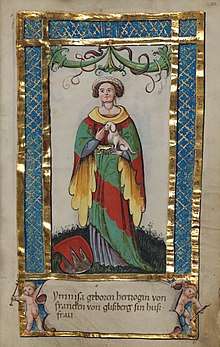Imiza of Luxembourg
Imiza of Luxembourg (also Irmentrude and Ermentrude) (c. 990/1000-died after c. 1055/6),[1] was a German noblewoman. She was the daughter of Frederick of Luxembourg, and the wife of Welf II of Swabia.
Imiza of Luxembourg | |
|---|---|
 Imiza in the Weingarten Stifterbüchlein, c. 1510 | |
| Born | c. 990/1000 |
| Died | after c. 1055/6 |
| Buried | Altomünster |
| Noble family | Ardennes-Luxembourg Elder House of Welf |
| Spouse(s) | Welf II, Count of Swabia |
| Issue | |
| Father | Frederick of Luxembourg |
| Mother | Ermentrude of Gleiberg |
Life
Imiza was the daughter of Frederick of Luxembourg and Ermentrude of Gleiberg.[2] She was a direct descendant of Charlemagne, and her maternal aunt, Cunigunde was married to Emperor Henry II.[3]
She was married to Welf II, Count of Swabia, probably in 1017.[4] Imiza’s dowry included the estates of Mehring am Lech (near Augsburg) and Elisina (modern Solesino).[5] Imiza probably received this property at the intervention of her aunt, Empress Cunigunde.[6] Probably because of this connection Henry II also granted the Duchy of Carinthia to Imiza's son, Welf III (previously Carinthia had been ruled personally by the German emperors).[7]
Imiza outlived her son, Welf III, who never married and had no children.[8] Welf bequeathed his property to the monastery of Altdorf, where his mother had become abbess.[9] She in turn gave the property to Welf IV, her grandson by her daughter Cunigunde.[10]
Issue
With Welf II, Imiza had two children:
References
- K. Baaken, ‘Elisina curtis nobilissima. Welfischer Besitz in der Markgrafschaft Verona und die Datierung der Historia Welforum,’ Deutsches Archiv 55 (1999), 63-94
- H. Dopsch, ‘Welf III und Kärnten,’ in D. Bauer, et al., eds., Welf IV. - Schlüsselfigur einer Wendezeit: Regionale und europäische Perspektiven (Munich, 2004), pp. 84–128.
- W. Glocker, Die Verwandten der Ottonen und ihre Bedeutung in der Politik (Böhlau Verlag, Cologne, Vienna, 1989).
- H. Renn, Das erste Luxemburger Grafenhaus (963-1136) (Bonn, 1941).
- B. Schneidmüller: Die Welfen. Herrschaft und Erinnerung (819–1252). (Stuttgart, 2000), pp. 119–123
- D. Schwennicke, Europäische Stammtafeln Neue Folge, vol. I.1 (Frankfurt am Main 1998).
- E. Steindorff, Jahrbücher des Deutschen Reichs unter Heinrich III., 2 vols. (Leipzig, 1874-1881), accessible online at: archive.org
- W. Störmer, ‘Die süddeutschen Welfen unter besondere Berücksichtigung ihrer Herrschaftspolitik im bayerisch-schwäbischen Grenzraum,’ in K-L. Ay, L. Maier and J. Jahn, eds., Die Welfen. Landesgeschichtliche Aspekte ihrer Herrschaft (Constance, 1998), pp. 57–96.
- W. Störmer, 'Die Welfen in der Reichspolitik des 11. Jahrhunderts,' Mitteilungen des Instituts für Österreichische Geschichtsforschung 104 (1996), 252-265.
External links
Notes
- Glocker, Die Verwandten der Ottonen, p. 348.
- Schwennicke, Europäische Stammtafeln, table 17.
- Renn, Das erste Luxemburger Grafenhaus, pp. 137ff.
- Schneidmüller, Die Welfen, p. 120. See, however, Störmer, ‘Die Welfen in der Reichspolitik,’ p. 257, who suggests that the marriage may have taken place in 1015; and Glocker, Die Verwandten der Ottonen, p. 348 who suggests that the marriage took place as early as 1005.
- Baaken, ‘Welfischer Besitz in der Markgrafschaft Verona,‘ esp. pp. 73f.
- Schneidmüller, Die Welfen, pp. 121-122
- Dopsch, ‘Welf III und Kärnten,’ p. 101.
- Steindorff, Jahrbücher, II, p. 319.
- Schneidmüller, Die Welfen, p. 127
- Störmer, ‘Die Welfen in der Reichspolitik,’ p. 261.